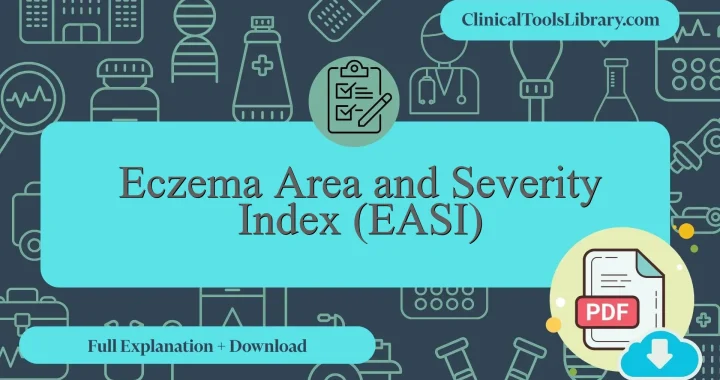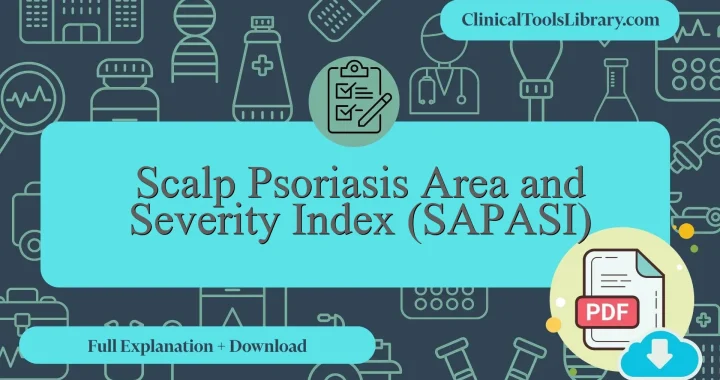In this article, we explain everything you need to know about the Eczema Area and Severity Index (EASI). We will cover the aspects it evaluates, the target population, a detailed step-by-step explanation, and how to interpret its results. Additionally, we will dive into the scientific evidence supporting this tool (diagnostic sensitivity and specificity) in clinical assessment. You will also find official and unofficial sources available for download in PDF format.
What does the Eczema Area and Severity Index (EASI) assess?
The Eczema Area and Severity Index (EASI) is a validated clinical tool designed to quantitatively assess the extent and severity of atopic dermatitis. It evaluates four anatomical regions—head/neck, trunk, upper limbs, and lower limbs—by measuring both the affected surface area and the intensity of key symptoms such as erythema, edema/papulation, excoriation, and lichenification. The primary purpose of the EASI is to provide an objective severity score that guides treatment decisions and facilitates monitoring of disease progression or therapeutic response. Healthcare professionals often utilize the EASI score calculator or refer to the Eczema Area and Severity Index PDF for standardized scoring methods. The resulting EASI score range typically spans from 0 to 72, with higher values indicating more severe manifestations. In clinical trials and practice, achieving an EASI-75 score—a 75% improvement from baseline—is commonly used as a benchmark for effective intervention. This index complements other assessment tools such as the IGA eczema score to provide a comprehensive evaluation of patient condition.
For which type of patients or populations is the Eczema Area and Severity Index (EASI) intended?
The Eczema Area and Severity Index (EASI) is primarily indicated for patients diagnosed with atopic dermatitis, encompassing both pediatric and adult populations exhibiting varying degrees of disease severity. It is most useful in clinical contexts requiring standardized assessment of disease extent and intensity, particularly in dermatology trials and routine practice to evaluate treatment efficacy. The EASI score ranges from 0 to 72, capturing both the affected body surface area and key inflammatory signs. Utilization of the EASI score sheet or EASI score calculator facilitates objective quantification, supporting informed decisions regarding therapeutic adjustments and enabling comparison with other metrics such as the IGA eczema score. The index also proves essential for achieving endpoints like the EASI-75 score, which denotes a 75% improvement in disease severity and is frequently employed in clinical trials assessing novel interventions.
Step-by-Step Explanation of the Eczema Area and Severity Index (EASI)
The Eczema Area and Severity Index (EASI) evaluates four body regions—head/neck, upper limbs, trunk, and lower limbs—assessing both the extent and severity of atopic dermatitis. The assessment involves four key items per region: erythema, edema/papulation, excoriation, and lichenification, each rated on a 0 to 3 scale reflecting severity. Additionally, the affected area within each region is estimated as a percentage, which is then converted to a numerical area score ranging from 0 to 6. The clinician multiplies the severity scores by the area score and region-specific weighting factors to calculate the final EASI score, which ranges from 0 (no eczema) to 72 (most severe). This standardized approach combines objective clinical signs with quantifiable extent, ensuring consistent evaluation across patients with eczema.
Eczema Area and Severity Index (EASI) PDF Resources: Score Sheets in Original & English
Below are downloadable resources featuring the Eczema Area and Severity Index (EASI) in both the original language and English versions, provided in PDF format for ease of use. These documents include the comprehensive EASI score sheet, allowing for standardized assessment of disease severity. Clinicians may utilize these tools to accurately determine the EASI score range and support effective patient management in cases of EASI Eczema.
How to interpret the results of the Eczema Area and Severity Index (EASI)?
The Eczema Area and Severity Index (EASI) quantifies the severity and extent of atopic dermatitis by evaluating four body regions for erythema, edema/papulation, excoriation, and lichenification. Scores range from 0 to 72, with higher values indicating greater disease burden. Typically, scores are interpreted as follows: 0 indicates no eczema, 1–7 represents mild disease, 8–21 corresponds to moderate severity, 22–50 signifies severe eczema, and >50 reflects very severe involvement. The EASI formula combines lesion severity and affected surface area weighted by anatomical region, enabling a comprehensive assessment. In clinical practice, changes in EASI score of 6 or more are considered clinically meaningful improvements. Healthcare professionals utilize these results to tailor treatment strategies, monitor therapeutic response, and adjust interventions accordingly, facilitating objective management of eczema.
What scientific evidence supports the Eczema Area and Severity Index (EASI) ?
The Eczema Area and Severity Index (EASI) is a rigorously validated tool widely utilized in the assessment of atopic dermatitis severity. Originating in the early 1990s through collaborative efforts among dermatology researchers, EASI quantifies both the extent and intensity of disease manifestations by evaluating four body regions with standardized criteria. Multiple studies have demonstrated its reliability, sensitivity to change, and reproducibility across diverse patient populations, making it a preferred endpoint in clinical trials. Validation efforts include correlations with other established measures such as the SCORing Atopic Dermatitis (SCORAD) index and patient-reported outcomes, confirming its objective assessment capabilities. Furthermore, the EASI score has been supported by longitudinal data reflecting treatment responses, reinforcing its scientific robustness in both research and clinical settings.
Diagnostic Accuracy: Sensitivity and Specificity of the Eczema Area and Severity Index (EASI)
The Eczema Area and Severity Index (EASI) is a validated tool commonly used to assess the extent and severity of atopic dermatitis. Sensitivity values for EASI in detecting changes in disease severity typically range from 70% to 85%, reflecting its ability to accurately identify patients experiencing clinical improvement or worsening. Specificity rates are similarly robust, generally reported between 75% and 90%, indicating its effectiveness in correctly classifying patients without significant disease progression. These metrics demonstrate that EASI provides reliable reproducibility and responsiveness in both clinical trials and routine practice, making it a cornerstone instrument for evaluating therapeutic outcomes in eczema management.
Related Scales or Questionnaires
The Eczema Area and Severity Index (EASI) is frequently compared to the Investigator’s Global Assessment (IGA eczema score), SCORing Atopic Dermatitis (SCORAD), and Patient-Oriented Eczema Measure (POEM). The IGA eczema score offers a simpler, faster assessment but lacks the detailed gradation of severity present in the EASI score, potentially reducing sensitivity to clinical changes. SCORAD incorporates both objective signs and subjective symptoms like itch and sleep loss, providing a more comprehensive overview; however, this complexity can limit its routine clinical use. POEM focuses on patient-reported outcomes, complementing clinician-administered tools but may not fully capture the physical extent of eczema. These scales and questionnaires, along with resources such as the EASI score calculator, Eczema Area and Severity Index PDF, and EASI score sheet, are thoroughly detailed and available for download on ClinicalToolsLibrary.com to assist healthcare professionals in selecting the appropriate instrument based on clinical or research needs.




